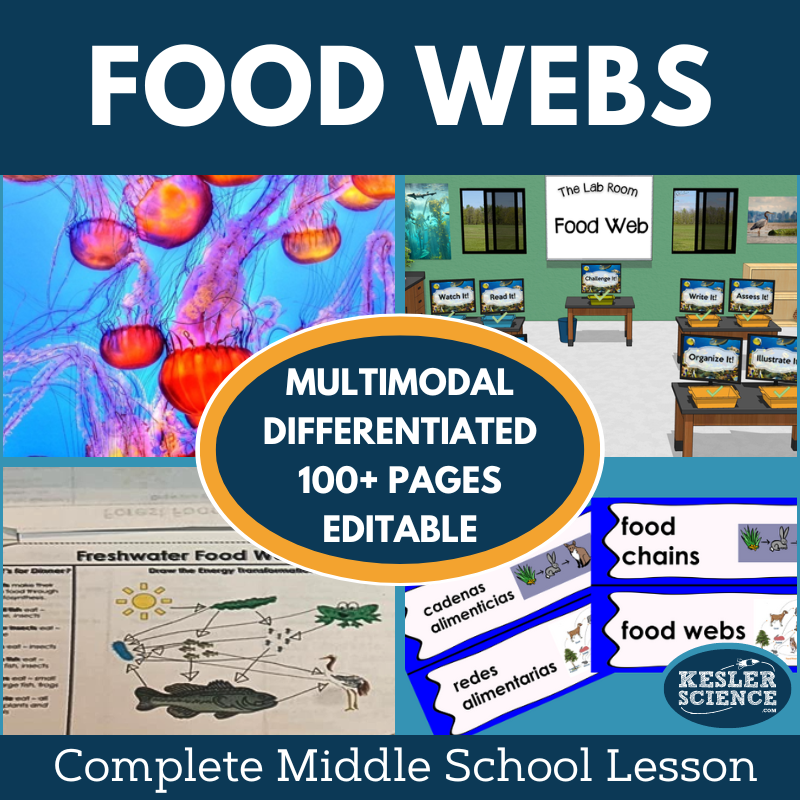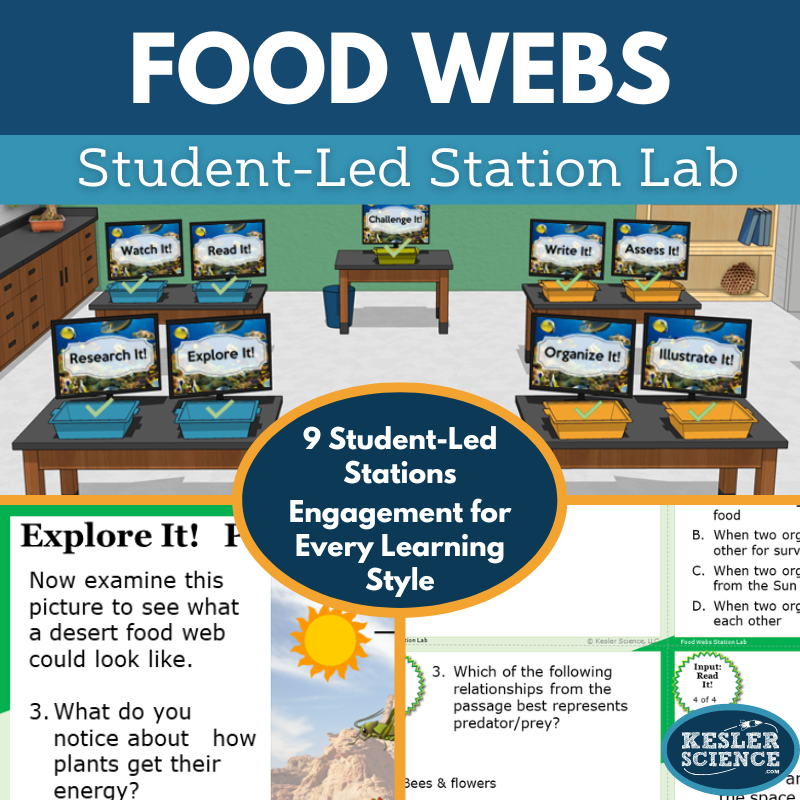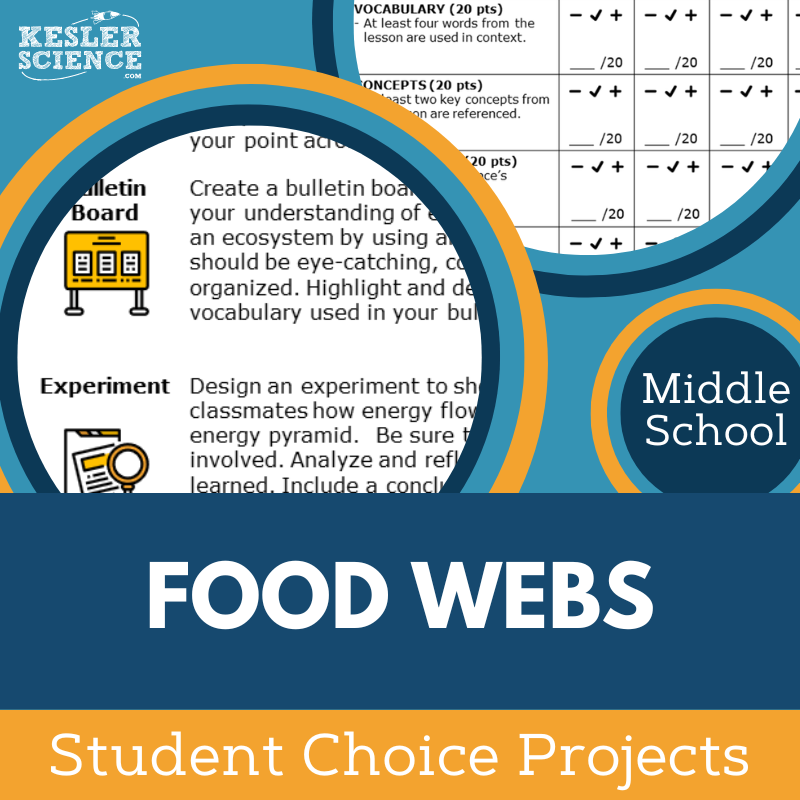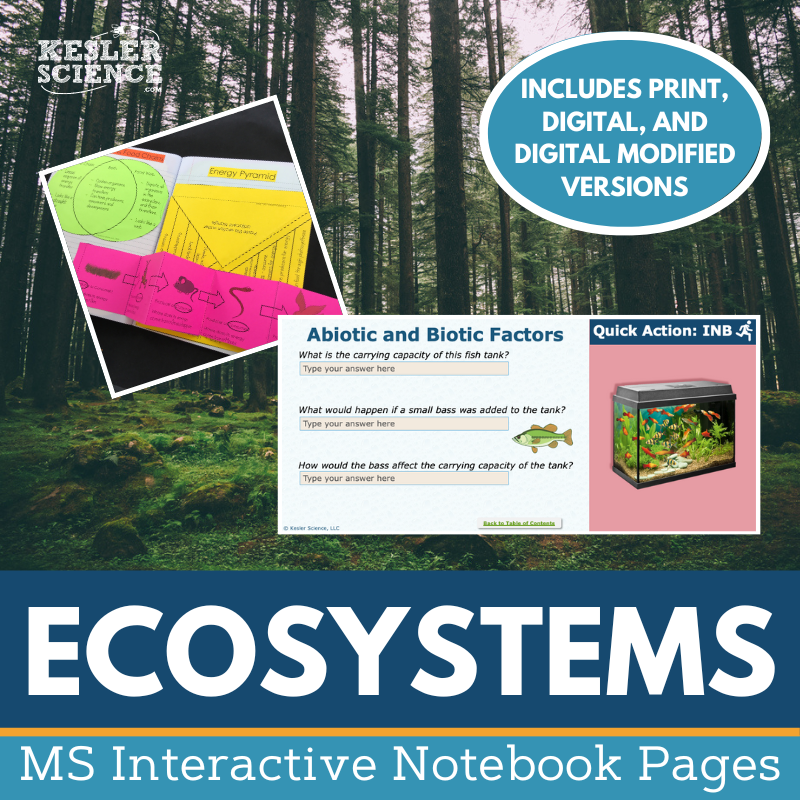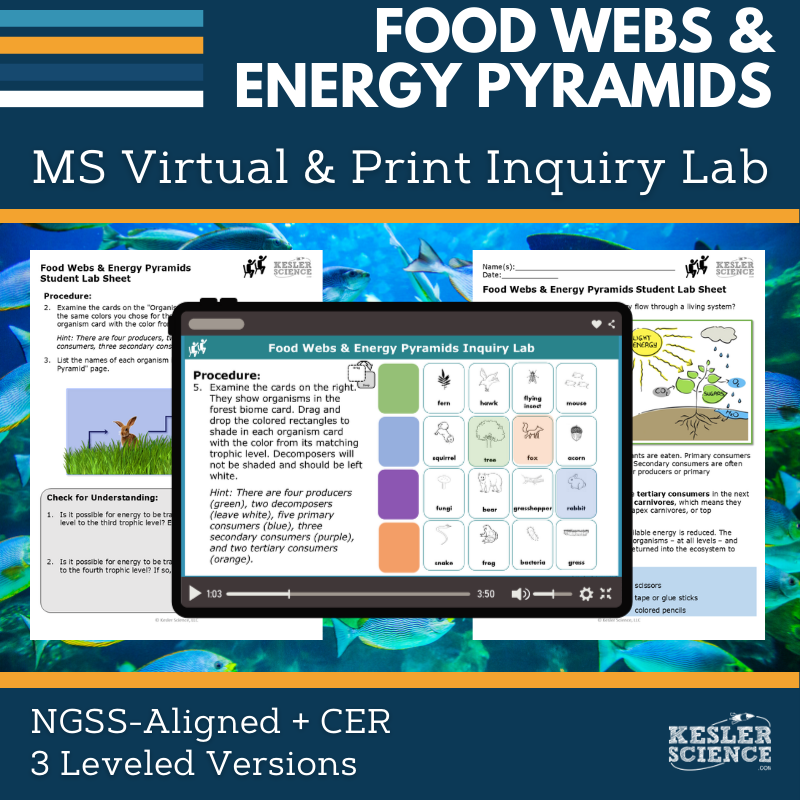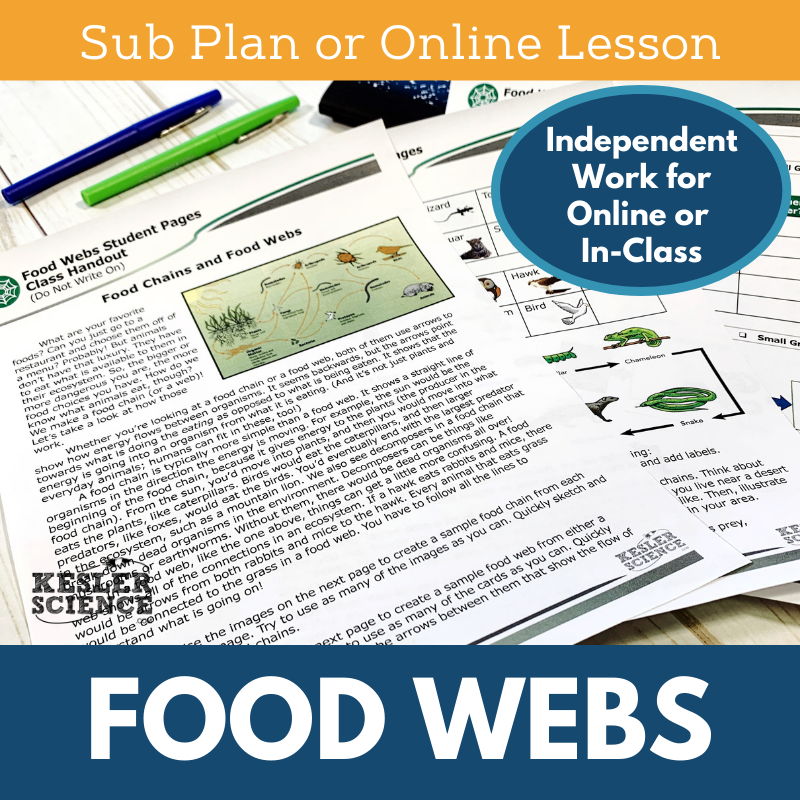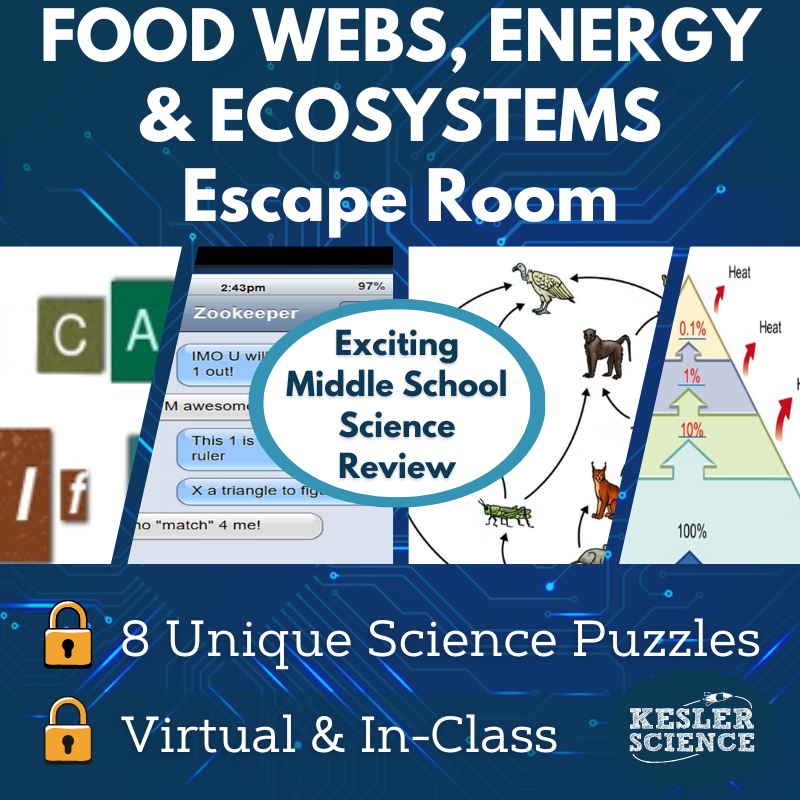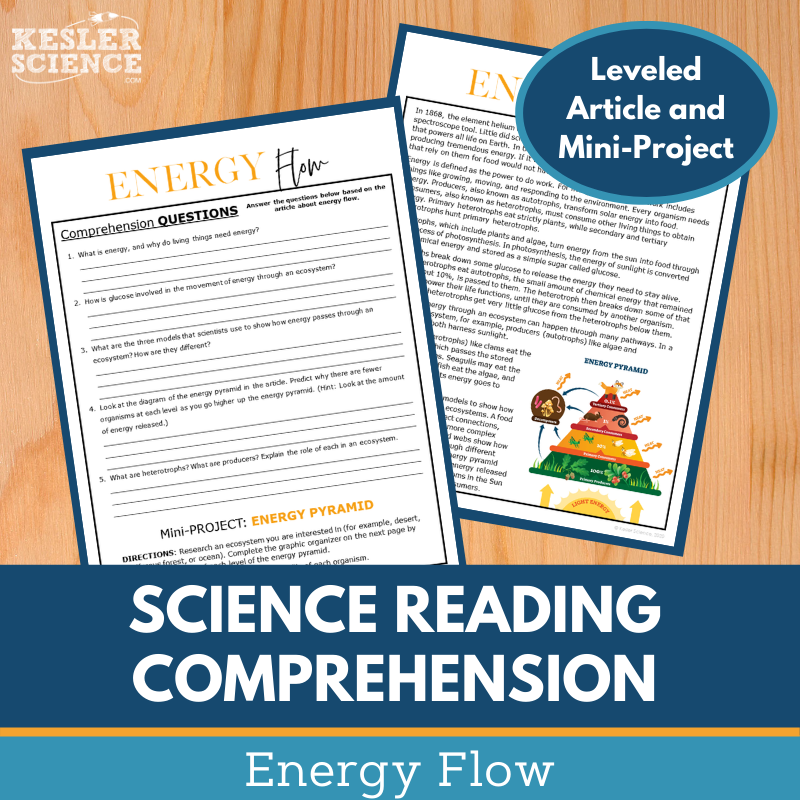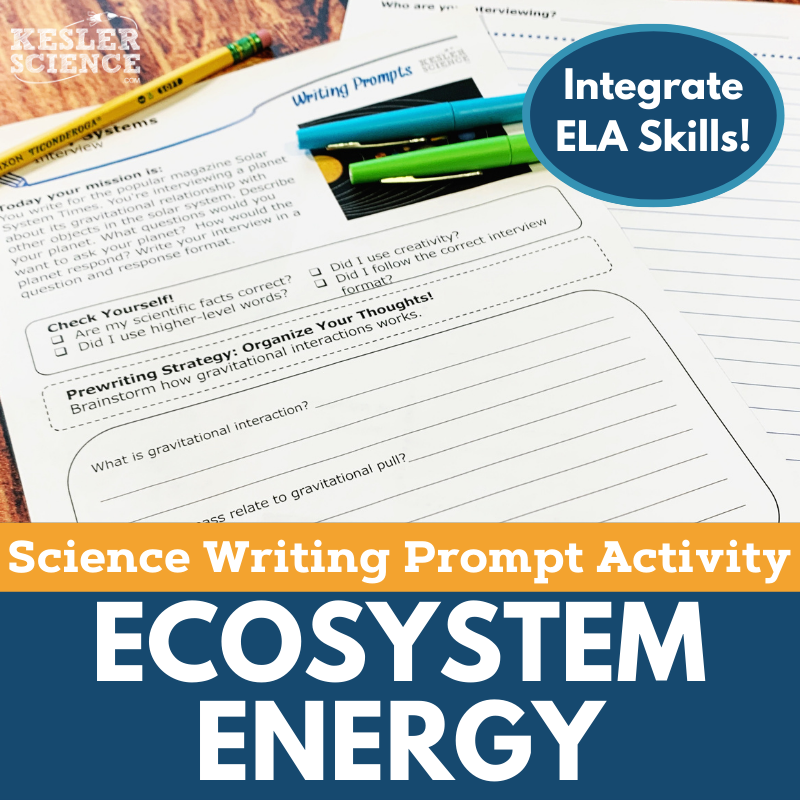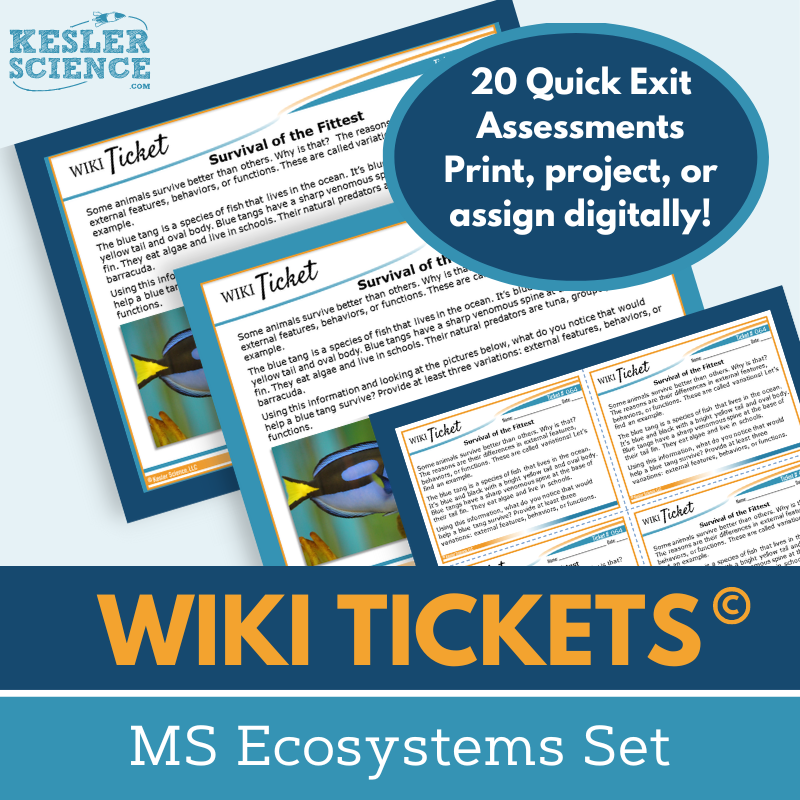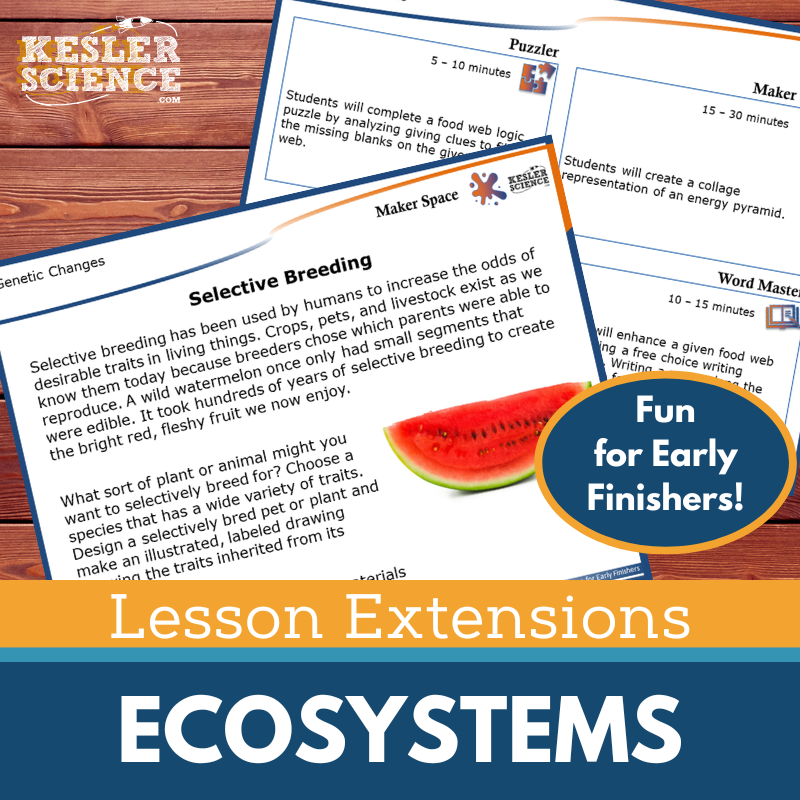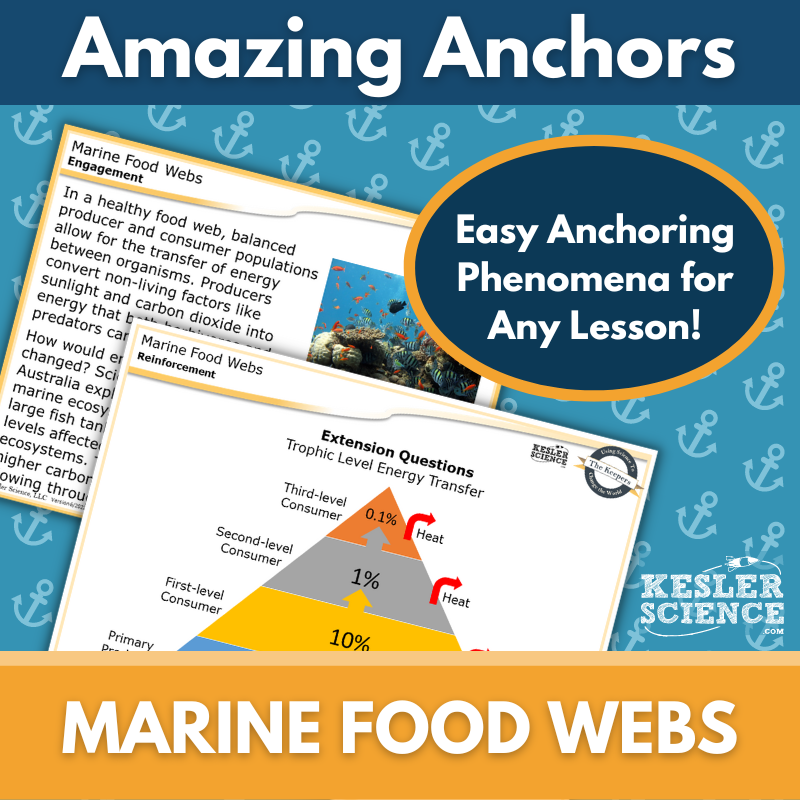Food Webs Activities for Middle School Science
The Kesler Science Food Webs Resources provide engaging, differentiated materials for middle school students to explore food chains, food webs, and energy flow through ecosystems. The resources below will give students a comprehensive understanding of food webs. All of the following materials are also included in the Kesler Science Membership.
The Kesler Science Food Webs and Energy Flow 5E Lesson is a comprehensive middle school unit guiding students to explore how energy moves through ecosystems and how to describe food webs across habitats. The unit incorporates editable presentations, worksheets, assessments, and student-choice projects designed for flexible, differentiated instruction in print or digital formats. With essential questions framing the learning, the multiday content supports both classroom and virtual environments.
Each phase of the 5E Model is fully supported. The engagement phase offers vocabulary tools, teacher prompts, and class activities. For exploration, students complete a station lab featuring nine varied input and output activities like hands-on demonstrations, videos, card sorts, writing tasks, and drawing exercises, with an additional challenge station for early finishers. Materials are provided in English and Spanish to support all learners.
During the explanation phase, editable PowerPoints and interactive notebook templates guide direct instruction. In elaboration, students select from extension projects to deepen their understanding. The evaluation phase includes STAAR 2.0-style assessments and review materials. Whether used in class or online, this lesson delivers student-led learning that promotes critical thinking and science literacy.
The Kesler Science Food Webs and Energy Flow 5E Lesson is a comprehensive middle school unit guiding students to explore how energy moves through ecosystems and how to describe food webs across habitats. The unit incorporates editable presentations, worksheets, assessments, and student-choice projects designed for flexible, differentiated instruction in print or digital formats. With essential questions framing the learning, the multiday content supports both classroom and virtual environments.
Each phase of the 5E Model is fully supported. The engagement phase offers vocabulary tools, teacher prompts, and class activities. For exploration, students complete a station lab featuring nine varied input and output activities like hands-on demonstrations, videos, card sorts, writing tasks, and drawing exercises, with an additional challenge station for early finishers. Materials are provided in English and Spanish to support all learners.
During the explanation phase, editable PowerPoints and interactive notebook templates guide direct instruction. In elaboration, students select from extension projects to deepen their understanding. The evaluation phase includes STAAR 2.0-style assessments and review materials. Whether used in class or online, this lesson delivers student-led learning that promotes critical thinking and science literacy.
The Kesler Science Food Webs Station Lab offers a modular, student-led approach to learning about ecosystems and the impact of populations on their environment. This engaging resource features eight differentiated stations and a bonus challenge station, allowing students to take charge of their learning while teachers facilitate. With minimal prep time, this activity saves time and keeps middle schoolers actively involved.
The nine stations are divided into input and output activities, providing a multimodal learning experience. Input stations like "Explore It!" and "Watch It!" help students grasp new concepts through hands-on demonstrations, videos, and research tasks, with materials available in English and Spanish. Output stations such as "Organize It!" and "Illustrate It!" let students demonstrate their understanding through sorting activities, drawing models, and writing prompts.
This versatile station lab is perfect for both in-person and virtual learning environments. With included task cards, resources, and extension activities for early finishers, it ensures every student can engage deeply with the content and extend their knowledge of food webs.
The Kesler Science Food Webs Station Lab offers a modular, student-led approach to learning about ecosystems and the impact of populations on their environment. This engaging resource features eight differentiated stations and a bonus challenge station, allowing students to take charge of their learning while teachers facilitate. With minimal prep time, this activity saves time and keeps middle schoolers actively involved.
The nine stations are divided into input and output activities, providing a multimodal learning experience. Input stations like "Explore It!" and "Watch It!" help students grasp new concepts through hands-on demonstrations, videos, and research tasks, with materials available in English and Spanish. Output stations such as "Organize It!" and "Illustrate It!" let students demonstrate their understanding through sorting activities, drawing models, and writing prompts.
This versatile station lab is perfect for both in-person and virtual learning environments. With included task cards, resources, and extension activities for early finishers, it ensures every student can engage deeply with the content and extend their knowledge of food webs.
The Kesler Science Food Webs Student Choice Projects give middle school students the freedom to select a project that suits their learning style, encouraging creativity and personalized expression. With six unique project options and a “design your own” choice, students can demonstrate their understanding of food webs in ways that resonate with their strengths. A flexible, editable grading rubric supports assessment by teachers, peers, or self-evaluation.
This resource offers differentiation to meet diverse student needs. The modified project page includes tailored options for students requiring extra support, while advanced learners can be challenged with multiple projects. Clear teacher directions and editable rubric pages streamline implementation, making it easy to customize the experience for any classroom.
Projects require minimal materials like paper, markers, and scissors, with optional crafting supplies for model-building. Many tasks can also be completed digitally, ensuring accessibility and adaptability for any learning environment. These projects engage students while fostering deeper understanding of ecosystems and food webs.
The Kesler Science Food Webs Student Choice Projects give middle school students the freedom to select a project that suits their learning style, encouraging creativity and personalized expression. With six unique project options and a “design your own” choice, students can demonstrate their understanding of food webs in ways that resonate with their strengths. A flexible, editable grading rubric supports assessment by teachers, peers, or self-evaluation.
This resource offers differentiation to meet diverse student needs. The modified project page includes tailored options for students requiring extra support, while advanced learners can be challenged with multiple projects. Clear teacher directions and editable rubric pages streamline implementation, making it easy to customize the experience for any classroom.
Projects require minimal materials like paper, markers, and scissors, with optional crafting supplies for model-building. Many tasks can also be completed digitally, ensuring accessibility and adaptability for any learning environment. These projects engage students while fostering deeper understanding of ecosystems and food webs.
The Kesler Science Ecosystems Interactive Notebook Bundle provides an engaging and interactive way for students to explore key ecosystems concepts. Designed for flexibility, the resource includes both print and digital versions, making it suitable for traditional classrooms, 1:1 environments, and distance learning settings.
The bundle covers a wide range of topics, including biotic and abiotic factors, biomes, food webs, symbiosis, and the nitrogen and carbon cycles. Digital features include a unique interactive notebook PowerPoint, editable Google Slides compatibility, reflection pages, and modified versions for students with accommodations. The paper version includes blank and pre-filled templates, complete with color examples to guide students and teachers.
This resource supports differentiated instruction and accommodates all learners with thoughtfully designed templates and modifications. Whether in person or online, the Ecosystems Interactive Notebook promotes active learning, critical thinking, and scientific literacy.
The Kesler Science Ecosystems Interactive Notebook Bundle provides an engaging and interactive way for students to explore key ecosystems concepts. Designed for flexibility, the resource includes both print and digital versions, making it suitable for traditional classrooms, 1:1 environments, and distance learning settings.
The bundle covers a wide range of topics, including biotic and abiotic factors, biomes, food webs, symbiosis, and the nitrogen and carbon cycles. Digital features include a unique interactive notebook PowerPoint, editable Google Slides compatibility, reflection pages, and modified versions for students with accommodations. The paper version includes blank and pre-filled templates, complete with color examples to guide students and teachers.
This resource supports differentiated instruction and accommodates all learners with thoughtfully designed templates and modifications. Whether in person or online, the Ecosystems Interactive Notebook promotes active learning, critical thinking, and scientific literacy.
The Food Webs and Energy Pyramid Lab aligns with NGSS MS-LS1-6 and helps students construct explanations for the role of photosynthesis in the cycling of matter and energy flow within living systems. Students will explore energy transfer through food chains, food webs, and energy pyramids by either engaging in hands-on group activities or completing interactive digital labs. Both versions feature comprehension questions, Claim-Evidence-Reasoning (C.E.R.) prompts, and a reflection section.
This lab includes three differentiated versions—modified, on-level, and independent—making it adaptable for all learners. In the print version, students use yarn, tape, and organism cutouts to model energy pathways in a forest biome. The digital version, requiring no physical materials, provides an alternative for remote learners or students without access to supplies, and is fully compatible with Google Slides and other classroom platforms.
Additional resources include editable PowerPoints, answer keys, teacher guides, and flexible digital and printable formats. The lab promotes multimodal learning and allows teachers to customize the content to meet diverse classroom needs.
The Food Webs and Energy Pyramid Lab aligns with NGSS MS-LS1-6 and helps students construct explanations for the role of photosynthesis in the cycling of matter and energy flow within living systems. Students will explore energy transfer through food chains, food webs, and energy pyramids by either engaging in hands-on group activities or completing interactive digital labs. Both versions feature comprehension questions, Claim-Evidence-Reasoning (C.E.R.) prompts, and a reflection section.
This lab includes three differentiated versions—modified, on-level, and independent—making it adaptable for all learners. In the print version, students use yarn, tape, and organism cutouts to model energy pathways in a forest biome. The digital version, requiring no physical materials, provides an alternative for remote learners or students without access to supplies, and is fully compatible with Google Slides and other classroom platforms.
Additional resources include editable PowerPoints, answer keys, teacher guides, and flexible digital and printable formats. The lab promotes multimodal learning and allows teachers to customize the content to meet diverse classroom needs.
The Kesler Science Food Webs Sub Plans provide a ready-to-use lesson that includes a warm-up, reading passage, engaging activities, and an assessment. Students will explore food chains and food webs through trading cards, complete extension activities like puzzles or analysis of predator/prey relationships, and demonstrate understanding in a structured, student-friendly format. The plans ensure seamless instruction, even in your absence.
Designed for in-class or distance learning, the sub plans include detailed substitute directions, behavior checkpoints, and editable student PDFs for annotation or LMS integration. With options for Google Forms answer sheets, these plans are perfect for keeping students engaged and on-task while accommodating digital learning needs.
Kesler Science Sub Plans are versatile and comprehensive, featuring all necessary materials for a productive day, such as answer keys, extension activities for early finishers, and behavior management tools. These plans can also be used for ISS, homework, extra credit, or small group settings, ensuring flexibility and success in any classroom environment.
The Kesler Science Food Webs Sub Plans provide a ready-to-use lesson that includes a warm-up, reading passage, engaging activities, and an assessment. Students will explore food chains and food webs through trading cards, complete extension activities like puzzles or analysis of predator/prey relationships, and demonstrate understanding in a structured, student-friendly format. The plans ensure seamless instruction, even in your absence.
Designed for in-class or distance learning, the sub plans include detailed substitute directions, behavior checkpoints, and editable student PDFs for annotation or LMS integration. With options for Google Forms answer sheets, these plans are perfect for keeping students engaged and on-task while accommodating digital learning needs.
Kesler Science Sub Plans are versatile and comprehensive, featuring all necessary materials for a productive day, such as answer keys, extension activities for early finishers, and behavior management tools. These plans can also be used for ISS, homework, extra credit, or small group settings, ensuring flexibility and success in any classroom environment.
The Kesler Science Food Webs Escape Room offers an engaging, immersive experience where students can demonstrate their understanding of food webs, food chains, and energy transfer in ecosystems. Teachers have full control over the puzzles, allowing flexibility to choose and arrange the eight independent puzzles based on class length and needs.
To run the escape room, you can use manila envelopes for a simple setup or go for a more authentic experience with lockout hasps and locks. The materials included cover everything needed for both in-person and virtual settings, with printable resources and optional plastic animals for added fun. The product also offers two digital options: a Single Student Digital Version that works in Google Slides or a printable PDF version for home use.
What's included are teacher directions, an answer key, a video challenge, and a wide array of resources, including a digital answer sheet for Google Classroom, editable teacher versions, and reward templates. The puzzles are designed to be interactive and fun while reinforcing essential concepts about ecosystems.
The Kesler Science Food Webs Escape Room offers an engaging, immersive experience where students can demonstrate their understanding of food webs, food chains, and energy transfer in ecosystems. Teachers have full control over the puzzles, allowing flexibility to choose and arrange the eight independent puzzles based on class length and needs.
To run the escape room, you can use manila envelopes for a simple setup or go for a more authentic experience with lockout hasps and locks. The materials included cover everything needed for both in-person and virtual settings, with printable resources and optional plastic animals for added fun. The product also offers two digital options: a Single Student Digital Version that works in Google Slides or a printable PDF version for home use.
What's included are teacher directions, an answer key, a video challenge, and a wide array of resources, including a digital answer sheet for Google Classroom, editable teacher versions, and reward templates. The puzzles are designed to be interactive and fun while reinforcing essential concepts about ecosystems.
In the Kesler Science Energy Flow Reading Comprehension activity, students explore energy flow through living systems by reading a nonfiction article on food chains, food webs, and energy pyramids. They then complete comprehension questions and create an energy pyramid for a chosen organism. This science reading comprehension activity enhances middle school students' literacy and understanding of energy flow concepts in ecosystems.
The resource includes two leveled articles, with Lexile levels of 1100-1300, appropriate for grades 6-8 and higher-level 5th graders. Students will answer 5-7 comprehension questions and complete a mini-project, reinforcing the concepts learned. A Cornell notes template is included for students who need additional support, along with colorful graphics that can be printed in grayscale.
This resource is ideal for in-person or virtual learning environments, with files compatible with Google Classroom, MS Teams, and other platforms. It’s great for absent students, extra credit, sub plans, or whole-class instruction, and it encourages meaningful classroom discussions while building textual analysis and reading comprehension skills.
In the Kesler Science Energy Flow Reading Comprehension activity, students explore energy flow through living systems by reading a nonfiction article on food chains, food webs, and energy pyramids. They then complete comprehension questions and create an energy pyramid for a chosen organism. This science reading comprehension activity enhances middle school students' literacy and understanding of energy flow concepts in ecosystems.
The resource includes two leveled articles, with Lexile levels of 1100-1300, appropriate for grades 6-8 and higher-level 5th graders. Students will answer 5-7 comprehension questions and complete a mini-project, reinforcing the concepts learned. A Cornell notes template is included for students who need additional support, along with colorful graphics that can be printed in grayscale.
This resource is ideal for in-person or virtual learning environments, with files compatible with Google Classroom, MS Teams, and other platforms. It’s great for absent students, extra credit, sub plans, or whole-class instruction, and it encourages meaningful classroom discussions while building textual analysis and reading comprehension skills.
The Ecosystem Energy Science Writing Activity engages middle school students in a creative “call to action” writing prompt designed to reinforce their understanding of energy flow in ecosystems. This student-centered, low-prep resource helps learners extend their science reasoning skills while enriching their writing in a fun and meaningful way. The activity is suitable for both in-person and virtual settings, making it a flexible tool for life science instruction.
This TEKS- and NGSS-aligned resource includes teacher directions with rubrics and project ideas, projection and print handouts, and a digital version compatible with PowerPoint or Google Slides. Students receive full-sized and half-sheet layouts with pre-writing strategies and self-checks to guide their work, and the digital format allows completion in Edit mode for seamless classroom or remote learning.
Ideal for cross-curricular connections, formative assessments, student choice projects, or early finisher enrichment, this writing prompt can also be used for extra credit, make-up work, or TELPAS samples. The completed work can be showcased on bulletin boards or compiled into individual student anthologies, making it a versatile and engaging classroom resource.
The Ecosystem Energy Science Writing Activity engages middle school students in a creative “call to action” writing prompt designed to reinforce their understanding of energy flow in ecosystems. This student-centered, low-prep resource helps learners extend their science reasoning skills while enriching their writing in a fun and meaningful way. The activity is suitable for both in-person and virtual settings, making it a flexible tool for life science instruction.
This TEKS- and NGSS-aligned resource includes teacher directions with rubrics and project ideas, projection and print handouts, and a digital version compatible with PowerPoint or Google Slides. Students receive full-sized and half-sheet layouts with pre-writing strategies and self-checks to guide their work, and the digital format allows completion in Edit mode for seamless classroom or remote learning.
Ideal for cross-curricular connections, formative assessments, student choice projects, or early finisher enrichment, this writing prompt can also be used for extra credit, make-up work, or TELPAS samples. The completed work can be showcased on bulletin boards or compiled into individual student anthologies, making it a versatile and engaging classroom resource.
The Kesler Science Ecosystems WIKI Tickets are versatile formative assessments designed for 6th-8th grade science topics. These engaging assessments come in five formats for each topic: full screen for projection, three handout sizes (full, split, and quarter-page), and a digital interactive version that can be used as an editable PPT or Google Slides file. Perfect for checking understanding, these WIKI Tickets provide flexible options for in-person and virtual learning environments.
Aligned with NGSS and TEKS standards, each WIKI Tickets set includes a variety of topics like biodiversity, ecosystems, photosynthesis, and human impact. A bonus table of contents helps teachers quickly find the alignment for each standard. Some topics even have multiple tickets to reinforce key concepts and support student learning.
These assessments are ideal for use as exit tickets, bellringers, or anytime you need quick feedback on student progress. With digital and print formats available, they can be easily adapted for any classroom setting, providing a fun and effective way to gauge students' understanding of science concepts.
The Kesler Science Ecosystems WIKI Tickets are versatile formative assessments designed for 6th-8th grade science topics. These engaging assessments come in five formats for each topic: full screen for projection, three handout sizes (full, split, and quarter-page), and a digital interactive version that can be used as an editable PPT or Google Slides file. Perfect for checking understanding, these WIKI Tickets provide flexible options for in-person and virtual learning environments.
Aligned with NGSS and TEKS standards, each WIKI Tickets set includes a variety of topics like biodiversity, ecosystems, photosynthesis, and human impact. A bonus table of contents helps teachers quickly find the alignment for each standard. Some topics even have multiple tickets to reinforce key concepts and support student learning.
These assessments are ideal for use as exit tickets, bellringers, or anytime you need quick feedback on student progress. With digital and print formats available, they can be easily adapted for any classroom setting, providing a fun and effective way to gauge students' understanding of science concepts.
The Kesler Science Ecosystems Lesson Extensions offer student-choice activities to challenge fast finishers and encourage critical thinking. These activities provide engaging ways to deepen learning and can be used to wrap up lessons, prevent distractions, or fill gaps during testing. Each extension is designed to scaffold learning with activities that align with NGSS and TEKS standards, making them perfect for students ready to explore topics like ecosystems in more depth.
Included in each Lesson Extension are four activity types: Puzzler, Maker Space, Tech Connection, and Word Master. These activities focus on problem-solving, STEAM connections, digital media, and creative writing, providing opportunities for students to apply their knowledge in diverse and engaging ways. Both digital and paper versions are available, with teacher directions and answer keys for easy implementation.
These extensions are ideal for pushing independent learners further, offering rigorous, fun, and hands-on learning opportunities. With topics ranging from biodiversity to ecosystems and environmental changes, these resources help extend students' understanding of science concepts while reinforcing critical skills.
The Kesler Science Ecosystems Lesson Extensions offer student-choice activities to challenge fast finishers and encourage critical thinking. These activities provide engaging ways to deepen learning and can be used to wrap up lessons, prevent distractions, or fill gaps during testing. Each extension is designed to scaffold learning with activities that align with NGSS and TEKS standards, making them perfect for students ready to explore topics like ecosystems in more depth.
Included in each Lesson Extension are four activity types: Puzzler, Maker Space, Tech Connection, and Word Master. These activities focus on problem-solving, STEAM connections, digital media, and creative writing, providing opportunities for students to apply their knowledge in diverse and engaging ways. Both digital and paper versions are available, with teacher directions and answer keys for easy implementation.
These extensions are ideal for pushing independent learners further, offering rigorous, fun, and hands-on learning opportunities. With topics ranging from biodiversity to ecosystems and environmental changes, these resources help extend students' understanding of science concepts while reinforcing critical skills.
This Amazing Anchors Phenomenon Lesson introduces and reinforces the concept of energy flow in marine food webs through a real-world lens. The two-part resource includes an introductory reading on marine ecosystems with comprehension and extension questions to activate prior knowledge and guide student inquiry. An explanatory reading follows, breaking down the science of energy transfer within food webs and offering additional questions to reinforce learning.
Designed to supplement a main lesson, these readings are ideal for the Engagement and Elaboration phases of a 5E science unit. This TEKS-aligned resource includes teacher directions, answer keys, and editable materials that are ready to implement with minimal prep. Both print and digital versions are provided, including full-page projection slides and half-sheet handouts for interactive notebooks.
Differentiation is built into the lesson, with a modified version offering simplified language and sentence starters to support struggling learners. Whether used in person or through a digital platform, this no-prep activity encourages deeper understanding of food web dynamics in an engaging and accessible way.
This Amazing Anchors Phenomenon Lesson introduces and reinforces the concept of energy flow in marine food webs through a real-world lens. The two-part resource includes an introductory reading on marine ecosystems with comprehension and extension questions to activate prior knowledge and guide student inquiry. An explanatory reading follows, breaking down the science of energy transfer within food webs and offering additional questions to reinforce learning.
Designed to supplement a main lesson, these readings are ideal for the Engagement and Elaboration phases of a 5E science unit. This TEKS-aligned resource includes teacher directions, answer keys, and editable materials that are ready to implement with minimal prep. Both print and digital versions are provided, including full-page projection slides and half-sheet handouts for interactive notebooks.
Differentiation is built into the lesson, with a modified version offering simplified language and sentence starters to support struggling learners. Whether used in person or through a digital platform, this no-prep activity encourages deeper understanding of food web dynamics in an engaging and accessible way.
Year-Round Resources
These year-round activities will increase your students' understanding of many middle school science topics. All of these activities are also included in the Kesler Science Membership.
Visual Data & Graphing
You're not alone if your students struggle with understanding graphs, charts, and tables. It's a skill that takes an enormous amount of practice. This resource will help students build a strong foundation in analyzing data and creating their own data visualizations.
Bell Ringers and Warm-Ups
These middle school science bell ringers are an excellent way to engage your students as soon as they walk into your classroom. This comprehensive FULL YEAR resource includes everything you need to start off each science class with an interesting warm-up activity.
Review Board Games
Each game board has been carefully designed to keep students engaged. There are 10 different action spaces on each board and dozens of question cards. All of the actions are related to science concepts and keep the students motivated throughout the game.
Each game is ready to play. Simply print out the board and the cards and let the students enjoy reviewing nine different units.
Essential Questions
Below are the essential questions associated with the lessons and activities included in this unit. This topic is only one of more than 100 middle school science topics included in the Kesler Science Membership.
-
How can you diagram the energy flow through a living system?
-
How would you describe food webs in different ecosystems?
Kesler Science Membership
Imagine never having to search for another middle school science lesson again. The membership gives you access to ALL of the Kesler Science products in one place (Yes, including everything above).
Say goodbye to long hours of lesson prep.

